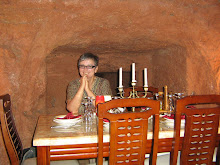
The culmination of the Maltese Natural Heritage course at University of Malta was a field trip to il-Majjistral nature and history park in the North of the island. The photo shows the stunning evening sun over the garigue as we were walking back to Golden Bay.
At the final Wednesday evening lecture, we were presented with our certificates by Dr Alan Deidun who was the convenor of the course. I have noticed his name now in newspaper articles about the environment, most recently an item on the encroachment of more apartment buildings on Mosta valley. The proposed site for development is remnant garigue with a well-preserved corbelled stone hut.
The girna or corbelled stone hut is a feature of the Maltese rural landscape. il-Majjistral is dotted with them and we actually went into one and were able to examine the construction closely. They are mostly built from coralline limestone with inward sloping rubble walls and a slab roof often supported by a beam probably in a similar fashion to the temple roofs.
We also came across some of the ancient cart ruts that can be found throughout Malta. How these were formed is still debatable but the consistent distance between two ruts shows that they are man-made. They are probably associated with Roman quarries. The question is about wheels or skids, and also whether the cart ruts were carved out beforehand to provide runners or were the result of constant erosion by whatever was dragged over the ground.
I have visited il-Majjistral before with Malta Geographical when we walked through the park from Golden Sands to Mellieha. This time we had an excellent guide, Annalise Falzon, who has contributed to a very good book about the park published in 2008. She is an environmental educator with Nature Trust and she can be booked in advance to lead circular two and a half hour walks around the park. I now have both the book and the booklet on the park so I can start to take visitors there.
As we walked, Analise stopped frequently to point out plants and give them their names. I can now recognise and remember Maltese spurge, Sicilian squill, Mediterranean stonecrop, Maltese sea Chamomile and wolfbane. We also saw three varieties of orchids that are in bloom at the moment. The heather is coming to the end of its flowering season and of course the invasive sorrel that was introduced from South Africa, probably by the British, is everywhere. There were a few large carob trees shaped by the prevailing winds and some invasive acacias planted by hunters who continue to shape the Maltese landscape.
il-Majjistral was almost lost to a proposed golf course but thankfully was saved probably because it was economically unsustainable rather than because of the rich diversity of flora and fauna that the habitat supports. Analise pointed out that any environmental study needs to be undertaken over a full year if not longer because many species are dormant for parts of the year and the landscape is constantly changing depending on the season.
The habitat also varies across the plateau and to the cliff edge. The five layers of deposits that make up Malta show their impact at the cliff face. The upper coralline layer cracks as the blue clay is squeezed out and the upper layer drops so there are two levels close to the sea with the lower level boulder strewn and rugged. This makes it hard to access so many rare plants and animals thrive with more water and soil trapped between rocks enabling trees to grow including olives, figs and some carobs.
There are rock-hewn stairways cut into the cliff face and some tiny rubble walled fields have been cultivated at one time on the lower level. But the stairs are hard to spot to prevent invasive access from the sea. We also went into a rock-cut square cave cut into the top of the cliff face perhaps as a British outpost or even a bomb shelter though I can't imagine why there would have been bombs dropped in this remote place. When we entered the park from Golden Bay, we had walked up through the old cave village that we walked past on my previous visit but these dwelling caves are very different from the cliff edge cave. There has also been a British army post in the valley area and the garigue shows evidence of their presence in several places.
At the conclusion of the lecture on Wednesday, Dr Deidun told us about a course on marine ecology including some diving field trips that he is convening in July. I won't be here for that but I have made a note to enroll if they run it in 2010 when I return to Malta. The more I learn here, the more I discover how complex and deep the world is!

No comments:
Post a Comment